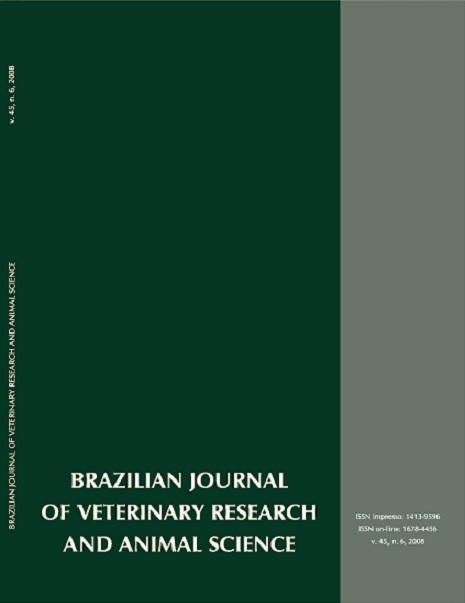Comparative study of the citrus pulp to cause acute rumen lactic acidosis in cattle
DOI:
https://doi.org/10.1590/S1413-95962008000600002Keywords:
Lactic acidosis, Citrus pulp, Rumen pH, CattleAbstract
With the aim to evaluate the risk of citrus pulp to induce acute rumen lactic acidosis (ARLA), 15 rumen cannulated cattle didn't adapted to concentrates were randomly allocated in 3 groups: G1- CONTROL - group fed only the basal diet; G2 - SUCROSE animals with ARLA induced by rumen administration of sucrose; G3 CITRUS PULP animals received citrus pulp into rumen (1.65% of BW). Blood and rumen samples were drawn throughout the next 24 h to determine pH, lactic acid concentration and the packet cell volume, blood base excess. Clinical signs were also recorded and food intake followed by the next 7 days. Sucrose caused a systemic and ruminal acidosis and characteristic ARLA signs such as, apathy, dehydration, diarrhea and tachycardia, while citrus pulp gave rise to mild and brief rumen acidosis, reaching the lowest pH (5.35) at the 6th h, without any changing in the blood pH and any typical clinical sign, but temporary reduction in the rumination and excretion of semi liquid feces. Appetite was fully recovered after two and seven days in the pulp and sucrose group, respectively. These results showed that citrus pulp may be used as a feedstuff for cattle with low risk to cause ARLA.Downloads
Download data is not yet available.
Downloads
Published
2008-12-03
Issue
Section
UNDEFINIED
License
The journal content is authorized under the Creative Commons BY-NC-SA license (summary of the license: https://
How to Cite
1.
Barrêto Júnior RA, Minervino AHH, Rodrigues FAML, Antonelli AC, Sucupira MCA, Mmori CS, et al. Comparative study of the citrus pulp to cause acute rumen lactic acidosis in cattle. Braz. J. Vet. Res. Anim. Sci. [Internet]. 2008 Dec. 3 [cited 2026 Jan. 5];45(6):421-8. Available from: https://revistas.usp.br/bjvras/article/view/26664





